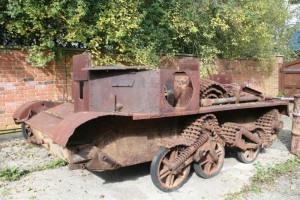1940’s Scout Tank found in Australia
On a cold and miserably wet autumnal day, late in 2012, our very own Derrick Etherden stands in the pouring rain at Southampton Port, supervising the unloading of a special shipment unloading from a container originating from Australia.
Derrick had been coordinating the customs clearance and release of a very special vehicle for our client, Ben Hawkins, a pattern maker working for a Formula One team. Married with a young family, Ben is a self-proclaimed strange vehicle enthusiast; he enjoys working with ‘strange vehicles with tracks’ as they have character! The ‘strange vehicle’ in question is a WW11 Scout Tank. Ben Explains;
 “The scout carrier mk1 L built under contract from the government for use in the enlargement of the army due to the expected conflict (ww2). It was built by Aveling Barford in 1939 and delivered on the 14/7 and it carries the registration RMY 683 ( I found it yesterday under the top layers of paint!)”
“The scout carrier mk1 L built under contract from the government for use in the enlargement of the army due to the expected conflict (ww2). It was built by Aveling Barford in 1939 and delivered on the 14/7 and it carries the registration RMY 683 ( I found it yesterday under the top layers of paint!)”
“Scouts were only really used in two theatres of ww2. France, with the British expeditionary force and the retreat at Dunkirk etc, all carriers used were destroyed or captured. The other was north Africa, we think that it served with the British army there until it was abandoned or adopted by the Australian army. They took it back to Australia (unofficially they were never given any scouts) and there it was used by their home defence army and the pictures of the carrier were taken during an event to publicise war bonds. It was sold after it was of no use to a farmer who wanted the engine. It was found about 5 years ago on the same farm were it had been abandoned by an Australian enthusiast, Phillip Hastings. He had it until it was sold to me earlier this year. You obviously know about the shipping etc from Freemantle to Southampton!”
It’s the only known surviving scout carrier left and will be restored by me to it’s original working condition. I plan on doing some more research into who used it in the desert and how it came to be in Australia. It’s remarkably complete including it’s original engine and boxes for ammunition and stowage. Most of the bits had been removed to get the engine out in the 1940’s and were found by Phillip scattered around the farm. The dry conditions have helped to preserve it in such fantastic condition. One headlight was missing as the farmer’s son remembers taking it off and fixing it to his truck to hunt kangaroos!”
“I’ve included a photo of the reg number found by carefully sanding the paint off one layer at a time. Let me know if I can be of any more help, if anybody that reads you article can help in any way or had family that served in north Africa or in France with the BEF I’d be pleased to hear from them.”
An update from Ben, just prior to launching this story online; “The news is I’ve started to strip it down ready to sand blast and repair. I believe it was part of a Dessert Rat unit used in an attack on Fort Capuzzo in 1940 but I can’t confirm this yet. The unit info may be as good as it ever gets, tracing vehicles is particularly hard”
If anyone has information relating to this wonderful story, or would like to know more , please email our managing director, Ross Negus (ross@sotonfreight.co.uk), and he’ll put you touch with Ben.
Soton Freight on Facebook
Unable to display Facebook posts.
Show error
Type: OAuthException
Code: 190
Please refer to our Error Message Reference.


